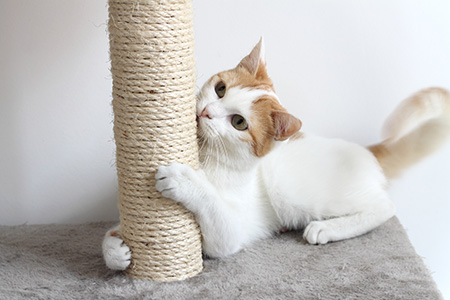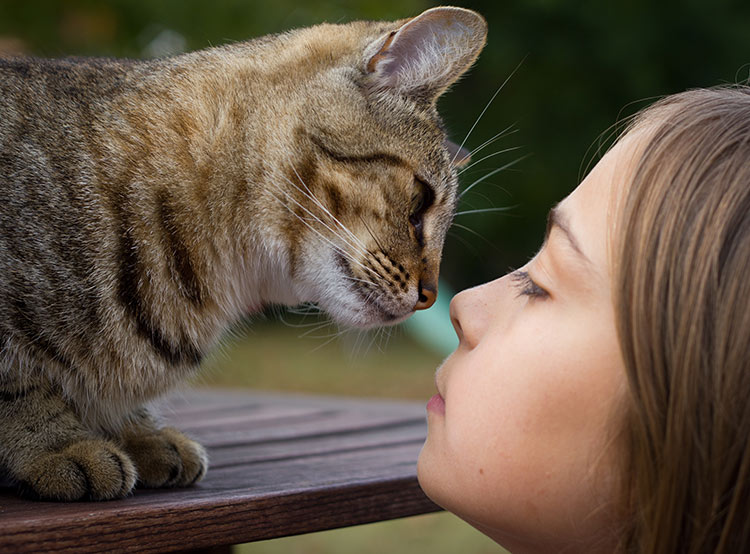cat behavior cat scratching kitty litterbox
Buster’s Vision Education Tool
Cat Behavior and Training
Editor, Meet Gulati
May 5, 2017
Share this Post
“In ancient times cats were worshipped as gods; they have not forgotten this.”Terry Pratcett
What makes “Cat Behavior” so captivating?
If you’ve seen a lion or a tiger, you’ll notice that they’re just larger versions of your own cat. They move, stalk, and play the same spellbinding way. At heart, your cat is pretty much like its wild cousins. Let’s dive right into discovering what goes on in the mind of our fabulous felines and why they behave a certain way. What makes cats so appealing is their elusive, mysterious nature. Dogs are open books, but cats are a spellbinding puzzle for researchers and cat lovers alike. Although cats domesticated themselves over 10,000 years ago, much remains to be learned about cat behavior. Their habits, such as cat scratching or how they use the kitty litter box.
Cat behavior Includes:
-
Vocalization
Cats vocalize in many ways depending on their breed, their mood, and whom they are talking to.
-
Purr
The purr is a continuous, soft, vibrating sound made in the throat by most cat species. Domestic kittens can purr as early as two days of age. Purring is often believed to indicate a positive emotional state, but cats sometimes purr when they are ill, tense, experiencing painful moments or are dying. Did you know that a cat’s purr is also believed to have healing benefits for humans?
-
Meow
A “Meow” or “Miaow” sound is the most familiar vocalization of adult cats. It can be assertive, plaintive, friendly, bold, welcoming, attention soliciting, demanding, or complaining. Adult cats do not meow to communicate with other cats. They only meow when speaking to their human guardians.
-
Chirr
The chirr or chirrup sounds like a meow rolled on the tongue. It is commonly used by mother cats to call their kittens inside the nest. Kittens recognize their own mother’s chirp and do not respond to the chirps of other mothers. It is also used by friendly cats, welcoming the approach of another cat or a human. Humans can mimic the sound to reassure and greet pet cats.
-
Chirping and Chattering
Cats sometimes make excited chirping or chattering noises when observing or stalking prey. Cats often chirp when bird or squirrel watching. Sometimes they chirp to get their guardian’s attention. These range from quiet clicking sounds, to loud but sustained chirping mixed with the occasional meow.
-
Trilling
Cats trill when they are happy to see someone; human and cat friends.
-
Humming
Some cats make a humming sound when they are anxious, to get their guardian’s attention, when they are hungry, or when they want to play.
-
Call
The call is a loud, rhythmic voice made with the mouth closed. It is primarily associated with female cats soliciting males, and sometimes when males fight with each other.
-
Growl, Snarl, Hiss, and Spitt
The growl, snarl, and hiss are all associated with either offensive or defensive aggression. They are usually accompanied by a postural display intended to have a visual effect on the perceived threat. Cats hiss when they are startled, scared, angry or in pain, and also to scare off intruders into their territory. If the hiss and growl warning does not remove the threat, an attack may follow. “Spitting” is a shorter but louder and more emphatic version of hissing.
Body Language
Cats have their own distinct ways of communicating with their tails, ears, eyes, and stance. Cats with tails held high (plumbing), eyes soft, ears forward, in a relaxed stance are happy and secure. A twitching tail is a warning. Ears back with eyes slit and back hunched means, “Watch out. I am not happy and I usually only say no only once”.

Elimination Habits
Cats instinctively bury their excrement (pee and poop) to protect themselves from predators. Kittens see their mothers burying their excrement either outdoors or in a litter box and follow suit. They do not need to be trained if their mother teaches them. Cats are fastidious. Most like to pee in one box and poop in another. Keep one extra box than the number of cats you have at home (For instance, one cat=2 boxes. 2 cats=3 boxes)
Boxes must be scooped at least once daily. Litter should be replaced and; the boxes washed and sanitized monthly. You may have to try a few different types of litter to find the one your cat likes. Boxes would be kept in a quiet, low-traffic, lighted area. If you are doing these things and your cat is not using its box; it is most likely sick or stressed. The first thing you should do is take your cat to the vet to ensure it does not have an infection, kidney stones, or some other ailment. Males are particularly susceptible to blockages, which can be deadly.
Scratching
Scratching is not only a natural instinct in cats, it also serves a necessary function. As a cat’s nail grows, the outer nail peels away. Scratching removes the outer layer. You cannot expect a cat to not scratch. To prevent your cat from scratching where you don’t want it to, make sure you have a scratching tree, pole, or mat to distract them in place before you bring your cat home. Some cats like boards covered in sisal or carpet on the floor, others like vertical scratching surfaces. The scratching surface should be longer or taller than your cat so that it can really stretch out and pull on those claws.
You may need to rub the scratching post with catnip to encourage your cat to use it. Take your cat to the post, stand them on their hind legs then, and then raising their arms slowly and softly, pull their front paws in a downward motion on the scratching post. Doing this often will help your cat get the hang of it. If your cat tries to scratch something else, redirect it to the post. Never, ever punish a cat or any animal for doing something instinctual. Declawing is a misnomer. It does not remove just the claw, but also the knuckle that the claw is attached to. Don’t attempt this cruel, painful, disfiguring amputation on your cat. If you’re not prepared for the possibility that your cat may scratch something you don’t want it to, don’t get a cat.

Eating Habits
Yes, cats are finicky! Feed your cat a healthy premium diet. Wet food is better than dry because cats by nature do not drink enough water. Cats have temperamental digestive systems. Do not abruptly change your cat’s diet, as it may result in vomiting and diarrhea. If you must change its diet, introduce the new food brand or texture slowly in small amounts mixed with its old food, gradually increasing the new and decreasing the old over a period of a few weeks. You must monitor your cat’s food intake daily and notify your vet immediately when you notice a change. Not eating is a matter of life and death in cats. See this video to learn why.
Playing
Cats, young and old, need to play. Play-time is a precious one-on-one time you have with your cat. Cats love to chase objects (balls, battery-powered mice, laser lights). They also love to hold stuffed toys by their front paws while lying on their backs and kicking the toy with their back feet. Cats must be taught from kittenhood that your hands are not toys. It may seem cute to have a young kitten bat on your fingers with their paws, claws out or to nip at your fingers with baby teeth. This will quickly cease to amuse you when those little claws and teeth grab you in earnest. Do not encourage your cat or kitten to play with your bare hands.
Marking
Male cats mark their territory by spraying a very unpleasant smelling liquid onto vertical surfaces. And so, this is just one of the reasons that both you and your cat will be much happier if you have him neutered. Your vet will know the right time to have your kitten neutered. For more information on spraying see why do cats spray?
Kneading
Kneading is a natural instinct in kittens while being nursed by their mothers for milk. They purr as they knead, since they feel nursing is a happy and secure time for them. They feel the same happiness while kneading their owners, a favorite blanket, a companion animal, or even a large stuffed toy. Kneading also activates sweat glands in a cat’s paws that mark the person or object being kneaded. Cats normally extend their claws while kneading. Again, this is normal and your cat is not trying to hurt you! Put a towel or blanket between you and your cat’s kneading paws and you will both benefit from the experience.
Training
Unlike dogs who hunt in packs, cats are solitary hunters who work alone to survive. While dogs working as a pack overwhelm their prey by numbers, strength, and power; cats overtake their prey by stealth and cunning having only its own speed and agility to rely on. Cats are motivated by reward. A trainer’s job is to understand the cat’s psychology and determine what motivates the cat they are training. Cats will not pursue that which is unrewarding or painful.
Cats do not respond to discipline. It should go without saying that you never hit a cat (or any other animal)! While an abused dog may continue to seek out the affection of its pack leader or owner, a cat reacts in fear either fleeing and hiding from the abuser, or hissing, growling and scratching. The cat will then become stressed and avoid the stressful situation (training) as well as the source of stress (the trainer, you). Punishing or disciplining a cat can lead to permanent stress and behavioral challenges that are extremely difficult to resolve.
The First Important Lesson
The first and the most important lesson should be to teach your cat to come when called. Try making a distinctive sound (maybe soft chirping noises) and then call your cat by name. You may have to do this several times. If the cat comes on its own with no further motivation, reward it with something pleasant. Does your cat like to be picked up and held? If so, pick it up, praising it all the while. Does it like its chin scratched? Then scratch and praise. Does it have a favorite toy or game? Then play and praise. Flatter your cat into obedience.
Using a Clicker
Using a clicker, a ballpoint pen that clicks open; or even making a distinctive clicking sound with your tongue after your cat has completed the desired behavior, provides immediate reinforcement.
Determine What Motivates Your Cat
- Food: Just the sound of the opening of the pantry door, a bag of cat food or a tin of treats can bring a cat running. Treats are normally effective.
- Brushing: Cats love it and will come running.
- Going into the catio or onto your screened-in porch.
- Play
Once you have determined what motivates your cat, training will be much easier.
While we continue to discover more about how you can read your cat’s mind, we’re sure they will always manage to keep some pages of their personality secret. But isn’t that what makes them so adorable and amazing?

